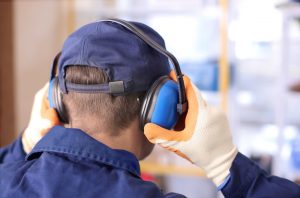As a teenager growing up on a farm, I rode loud tractors nearly every day. Listening to the tractor noise was no fun, so I wore headphones blaring loud heavy-metal music to cover it up.
My father was also a dentist. So in addition to the farm work, I often helped him out in his office, where the teeth-chattering noise of the dental drill blasted my eardrums.
By college, I was playing regularly in a jazz band. Several nights a week I sat directly in front of a trumpet line competing with each other to prove the brassman’s creed: “Higher, faster, louder.”
Some hereditary hearing loss already ran through my family, but that didn’t seem worth worrying about until my very distant golden years. And earplugs? Back then, no one around me even thought about wearing them.
Fast-forward to my mid-30s. My tractor days and Percy Sledge were behind me. I was in Washington, D.C., doing association work in an office building where the loudest noise was an occasional siren from the streets below.
But one day I attended a meeting in Montreal. I had been dispatched there simply as a representative to take notes and report back. We were in a conference room that happened to have a lot of white noise in the background. After about two hours, I realized I hadn’t understood enough of the conversation around the table to be able to report on what had transpired.
It was an embarrassing—and life-changing—predicament. I couldn’t believe it was happening to me. That’s when I began wearing hearing aids.
Today, I lead an industry association that focuses on workplace safety. When most people think of work-related safety, they picture hard hats, high-visibility vests, heavy-duty boots, and gloves. But ear protection? Not so much.
It’s not surprising. After all, sound waves are invisible. And humans tend to dismiss what we can’t see or touch.
Unfortunately, that’s a big mistake. Hearing protection is vital for many workers—and not just those riding tractors, drilling teeth, or using jackhammers. Everyday noises, especially in the workplace, are more dangerous than people realize.
How loud is too loud? At 85 decibels (dBA), which is about the noise level of city traffic, damage occurs after eight hours of exposure. But at 91 dBA, noise results in damage after only two hours.
Sound only becomes physically painful at about 125 dBA, so it is easy to exceed the 85-dBA threshold without realizing it. The longer your unprotected ears are exposed to a dangerous level of sound, the worse the damage to your eardrums—and your hearing.
For example, a 25-year-old carpenter who does not protect his hearing actually has the ears of a 50-year-old, according to the National Institute for Occupational Safety & Health (NIOSH). Carpenters’ daily noise exposure ranges from 85-107 dBA. A belt sander is 93 dBA.
Each year, 22 million workers are exposed to hazardous noise on the job, according to NIOSH, making hearing loss the third most common chronic physical condition among adults.
There are many occupations where the risk of dangerous sound levels are underestimated:
- Groundskeepers: 82-102 dBA (a leaf blower is 90 dBA)
- Music teachers: 84-91 dBA
- Farmers: 85-90 dBA
- Sanitation workers: 85-100 dBA
- Orchestra musicians: 95 dBA for brass sections, up to 130 dBA for peak percussion
- Ambulance drivers or EMTs: 110-140 dBA
- Air traffic controllers: 110-140 dBA from jet engines
- Construction workers: 85-100 dBA from jackhammers
- Warehouse workers: a forklift is 96 dBA
Permanent hearing loss is irreversible. It’s a problem that needs urgent attention, both from workers and their employers.
What can employers and workers do? Insist on using hearing protection. Depending on the types, levels and duration of noise, protection could mean simple earplugs all the way up to high-quality earmuffs.
Commercial noise monitoring equipment is available, but there are some good noise-level apps available these days for smartphones, too. The International Safety Equipment Association provides a hearing-safety section on our website that includes tips as well as links to those apps: HearingAtWork.org.
Remember the lesson I learned the hard way: Don’t cover up noise with more noise. Instead, protect your ears to prevent hearing loss. Because once your hearing is gone, you can’t get it back.
Charles Johnson is president of the International Safety Equipment Association (ISEA).

